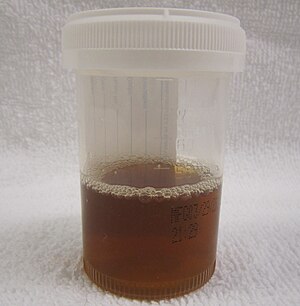Rhabdomyolysis
| Rhabdomyolysis | |
|---|---|
 |
|
| Urine from a person with rhabdomyolysis showing the characteristic brown discoloration as a result of myoglobinuria | |
| Pronunciation | /ˌræbdoʊmaɪˈɒlᵻsᵻs/ |
| Classification and external resources | |
| Specialty | Critical care medicine, nephrology |
| ICD-10 | M62.8, T79.5, T79.6 |
| ICD-9-CM | 728.88 |
| DiseasesDB | 11472 |
| MedlinePlus | 000473 |
| eMedicine | emerg/508 ped/2003 |
| MeSH | D012206 |
Rhabdomyolysis is a condition in which damaged skeletal muscle breaks down rapidly. Symptoms may include muscle pains, weakness, vomiting, and confusion There may be tea colored urine or an irregular heartbeat. Some of the muscle breakdown products, such as the protein myoglobin, are harmful to the kidneys and may lead to kidney failure.
The muscle damage is most often the result of a crush injury, strenuous exercise, medications, or drug abuse. Other causes include infections, electrical injury, heat stroke, prolonged immobilization, lack of blood flow to a limb, or snake bites. Some people have an inherited muscle conditions that increases the risk of rhabdomyolysis. The diagnosis is supported by a urine test strip which is positive for "blood" but urine which contains no red blood cells when examined with a microscope.Blood tests show a creatine kinase greater than 1,000 U/L, with severe disease being above 5,000 U/L.
The mainstay of treatment is large quantities of intravenous fluids. Other treatments may include dialysis or hemofiltration in more severe cases. Once urine output is established sodium bicarbonate and mannitol are commonly used but they are poorly supported by the evidence. Outcomes are generally good if treated early. Complications may include high blood potassium, low blood calcium, disseminated intravascular coagulation, and compartment syndrome.
...
Wikipedia
